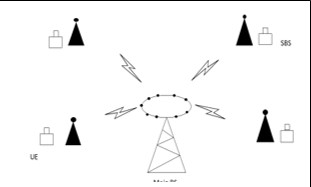Optimize Energy Efficiency Through Base Station Switching and Resource Allocation For 5g Heterogeneous Networks
Keywords:
Base station (BS) switching, Energy Efficiency, Resource Allocation, Spectrum Slicing, Traffic Modelling 5GAbstract
Energy and spectrum are the crucial factors on which future heterogeneous networks maintain green and sustainable development depends. Optimization of spectrum and power is the need of the day. The proposed algorithm uses Base Station (BS) switching model for the power optimization in which BS is made to sleep/ awake based on the user density and precursory observed data. With this dynamic control of the power of BS, a considerable power saving is observed. Spectrum optimization is attained using spectrum slicing, in which, initially, the traffic modeling is done considering user density, demand, and other parameters. Then the data assembled is deeply analyzed, and then Hidden Markov Model is used to allocate the spectrum based on the initial processing. This technique helps in the effective distribution of spectrum, and the spectrum can be appropriately utilized among the users belonging to different density groups having varied applications. The paper aims to increase spectral efficiency and power optimization with improvement in the Quality of Service (QoS) in addition to the user's quality of Experience (QoE).
Downloads
References
Li, Q. C., et al. (2014). 5G network capacity: Key elements and technologies. IEEE Vehicular Technology Magazine, 9(1), 1–78.
Gruber, M., et al. (2009). EARTH—Energy aware radio and network technologies. In 2009 IEEE 20th International Symposium on Personal, Indoor and Mobile Radio Communications, IEEE, pp. 1–5.
Han, C., et al. (2011). Green radio: radio techniques to enable energy-efficient wireless networks. IEEE Communications Magazine, 49(6), 46–54.
Yang, C., Li, J., Guizani, M., Anpalagan, A., & Elkashlan, M. (2016). Advanced spectrum sharing in 5G cognitive heterogeneous networks. IEEE Wireless Communications, 23(2), 94–101.
Abrol, A., & Jha, R. K. (2016). Power optimization in 5G networks: A step towards GrEEn communication. IEEE Access, 4, 1355–1374.
Jiang, Y., Liu, Q., Zheng, F., Gao, X., & You, X. (2016). Energyefcient joint resource allocation and power control for D2D communications. IEEE Transactions on Vehicular Technology, 65(8), 6119–6127.
Li, Q. C., et al. (2014). 5G network capacity: Key elements and technologies. IEEE Vehicular Technology Magazine, 9(1), 71–78.
Gupta, A., & Jha, R. K. (2017). Power optimization using massive MIMO and small cells approach in diferent deployment scenarios. Wireless Networks, 23(3), 959–973.
Mancuso, V., & Alouf, S. (2011). Reducing costs and pollution in cellular networks. IEEE Communications Magazine, 49(8), 63–71.
Gandotra, P., Jha, R. K., & Jain, S. (2017). A survey on device-todevice (D2D) communication: Architecture and security issues. Journal of Network and Computer Applications, 78, 9–29.
Yu, C.-H., & Tirkkonen O (2012) Device-to-device underlay cellular network based on rate splitting. In Wireless Communications and Networking Conference (WCNC), IEEE.
Abrol, A., et al. (2017). Joint power allocation and relay selection strategy for 5G network: A step towards green communication. Telecommunication Systems, 68, 1–15.
Foukas, X., Patounas, G., Elmokashfi, A., & Marina, M. K. (2017). Network slicing in 5 g: Survey and challenges. IEEE Communications Magazine, 55(5), 94–100.
Erfanian, J., & Daly, B. (2015). 5G white paper. Frankfurt: NGMN Alliance.
Zhang, H., Liu, N., Chu, X., Long, K., Aghvami, A. H., & Leung, V. C. (2017). Network slicing based 5G and future mobile networks: mobility, resource management, and challenges. IEEE Communications Magazine, 55(8), 138–145.
L. Saker and S. E. Elayoubi, "Sleep mode implementation issues in green base stations," in IEEE International Symposium on Personal, Indoor and Mobile Radio Communications, PIMRC, 2010, pp. 1683–1688.
B. Debaillie, C. Desset, and F. Louagie, "A flexible and future-proof power model for cellular base stations," IEEE Vehicular Technology Conference, vol. 2015, 2015.
Orange, "The 5G of the future: a network that will have the environment and low energy embedded in its technological DNA," 2015. [Online]. Available: http://www.orange.com/en/Commitments/ Responsibility/Environment/Climate- hange/COP/Folder/5G
NGMN, “NGMN 5G White Paper,” 2015. [Online]. Available: https: //www.ngmn.org/uploads/media/NGMN_5G_White_Paper_V1_0.pdf [5] G. Auer, O. Blume, V. Giannini, I. Godor, M. A. Imran, Y. Jading, E. Katranaras, M. Olsson, D. Sabella, P. Skillermark, and W. Wajda, "Energy efficiency analysis of the reference systems, areas of improvements and target breakdown," EARTH Project, pp. 1–69, 2010.
D. Ferling, P. Juschke, X. Yu, T. Bohn, A. Ambrosy, Y. Fernandez, A. Erdem, and A. Pascht, "Power saving by sleep modes in base station transceivers for LTE," in Asia-Pacific Microwave Conference Proceedings, APMC, 2012, pp. 947–949.
Theodore S Rappaport, Shu Sun, Rimma Mayzus, Hang Zhao, Yaniv Azar, Kevin Wang, George N Wong, Jocelyn K Schulz, Mathew Samimi, and Felix Gutierrez. Millimeter wave mobile communications for 5g cellular: It will work! IEEE Access, 1:335–349, 2013.
Wei Yu, Hansong Xu, Hanlin Zhang, David Griffith, and Nada Golmie. Ultra dense networks: State of art and future directions. In Proc. of IEEE International Conference on Computer Communication and Networks (ICCCN), 2016.

Downloads
Published
How to Cite
Issue
Section
License
Copyright (c) 2023 Amit Kumar Tiwari, Pavan Kumar Mishra, Sudhakar Pandey

This work is licensed under a Creative Commons Attribution-ShareAlike 4.0 International License.
All papers should be submitted electronically. All submitted manuscripts must be original work that is not under submission at another journal or under consideration for publication in another form, such as a monograph or chapter of a book. Authors of submitted papers are obligated not to submit their paper for publication elsewhere until an editorial decision is rendered on their submission. Further, authors of accepted papers are prohibited from publishing the results in other publications that appear before the paper is published in the Journal unless they receive approval for doing so from the Editor-In-Chief.
IJISAE open access articles are licensed under a Creative Commons Attribution-ShareAlike 4.0 International License. This license lets the audience to give appropriate credit, provide a link to the license, and indicate if changes were made and if they remix, transform, or build upon the material, they must distribute contributions under the same license as the original.





